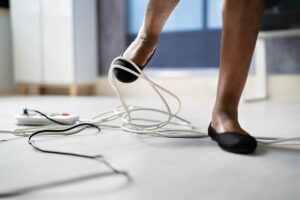 Snap, crackle, and pop belong in your cereal bowl, not in the electrical outlets and fixtures in your home. When your home’s electrical circuitry is unhealthy, it may tell you – with the loss of power to a circuit, electrical shocks to you and your family, or sparks and flames. Needless to say, none is acceptable, so use this checklist to avoid future problems.
Snap, crackle, and pop belong in your cereal bowl, not in the electrical outlets and fixtures in your home. When your home’s electrical circuitry is unhealthy, it may tell you – with the loss of power to a circuit, electrical shocks to you and your family, or sparks and flames. Needless to say, none is acceptable, so use this checklist to avoid future problems.
1) Electrical outlets – Check for loose-fitting plugs, which can be a shock or fire hazard. Replace missing or broken wall plates so wiring and components are not exposed. If you have young children in the home, cover unused outlets with plastic safety caps.
2) Plugs – Never force them into outlets. Don’t remove the grounding pin (third prong) to make a three-prong plug fit a two-prong outlet. Avoid overloading outlets with adapters and too many appliance plugs.
3) Cords – Make sure they are not frayed or cracked, placed under carpets or rugs, or located in high traffic areas. Do not nail or staple them to walls, floors or other objects.
4) Extension cords – Use them only on a temporary basis – they are not intended as permanent household wiring. Make sure they have safety closures to protect young children from shock and mouth burn injuries.
5) Light bulbs – Check the wattage to make sure light bulbs match the fixture requirements. Replace bulbs that have higher wattage ratings than recommended. Make sure they are screwed in securely so they don’t overheat.
6) Ground Fault Circuit Interrupters (GFCIs) – Make sure GFCI outlets are installed in your kitchen, bathrooms, laundry, workshop, basement and garage as well as on outdoor outlets. Test them monthly to ensure they’re working properly.
7) Circuit breakers/Fuses – Fuses should be properly sized for the circuit they are protecting. If you don’t know the correct rating, have an electrician identify and label the correct size to be used. Always replace a fuse with the same size you are removing. Check that circuit breakers are working properly.
8) Appliances/Electronics – If an appliance repeatedly blows a fuse, trips a circuit breaker or has given you an electrical shock, immediately unplug it and have it repaired or replaced. Look for cracks or damage in wiring and connectors. Use surge protectors to protect expensive electronics.
9) Electrical wiring – Wiring defects are a major cause of residential blazes. Check periodically for loose wall receptacles, loose wires, or loose lighting fixtures. Listen for popping or sizzling sounds behind walls. Immediately shut off, then professionally replace light switches that are hot to the touch and lights that spark and flicker.
10) Service capacity – As you continue to upgrade your home with more lighting, appliances and electronics, your home’s electrical service capacity may become overburdened. If fuses blow or trip frequently, have a professional electrician determine the appropriate service requirements for your home.
Keep your safety checklist, make notes, and refer back to it every time you give your home an electrical review. It will help you ensure you don’t miss anything and will serve as a good resource in the future. For more electrical safety information, visit www.SafeElectricity.org.
Molly Hall is the Director of Safe Electricity. E-mail molly-hall@SafeElectricity.org. Safe Electricity is a public awareness program of the Energy Education Council www.EnergyEdCouncil.org.







